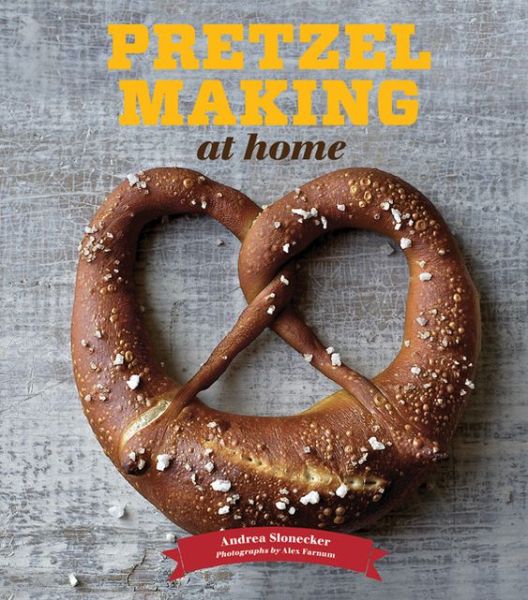Pretzel Making at Home
Photographs by Alex Farnum
The best pretzels are fresh from the oven. Andrea Slonecker has compiled a number of great recipes that will satisfy any home baker and pretzel lovers alike.
Here’s a new twist on an old favorite: pretzels warm from the oven. DIY bakers can make their own crunchy, chewy, savory, or sweet artisan pretzels with this collection of 50 recipes that imagines every way to shape, fill, and top them. Here are the traditional versions as well as novel creations such as Philly cheesesteak pretzel pockets and fried pretzel with cinnamon sugar. More substantial dishes like wild mushroom and chestnut pretzel stuffing, and pretzel bread pudding with caramel sauce elevate the humble pretzel to dinner-table fare as this tantalizing cookbook takes a cherished everyday snack to the next level of culinary creativity.
Andrea Slonecker is a food writer, recipe developer, and cooking teacher who bakes pretzels at home in Portland, Oregon.
Alex Farnum is a West Coast–based food photographer.
Buttery Pretzel Crackers
These buttery crisps are “pretzelized”—sprayed with an alkaline solution to give them that dark color and authentic pretzel flavor. You will need to pick up a plastic spray bottle in order to make this recipe. Store any remaining solution at room temperature in the spray bottle with the nozzle closed, as it will keep indefinitely. (Make sure the bottle can be used to safely store household cleaning products, in which case it will be fine for a lye solution.) Serve these with a cheese plate or a savory dip.
Dough
2 cups/255 g unbleached all-purpose flour, plus more for dusting
1 tbsp firmly packed light brown sugar
1 tsp fine sea salt, such as fleur de sel or sel gris
4 tbsp/55 g cold unsalted butter, cubed
¼ cup plus 3 tbsp/105 ml cold water
Alkaline Solution
1 cup/240 ml water
1 tsp food-grade lye or 2 tsp baked baking soda (see separate document for notes)
Coarse salt for topping
Makes 24 crackers
Whisk together the flour, brown sugar, and fine sea salt in a medium bowl. Use your fingertips to rub the butter into the flour mixture, breaking it up into tiny flour-coated pieces about the size of grains of rice. Add the water and stir with a rubber spatula to form a shaggy mass. Turn the dough out onto an unfloured work surface and knead it 8 to 10 times, just until all of the flour is incorporated. The dough should be slightly tacky but not sticky. If it is sticky, add a little more flour, about 1 tbsp at a time. (If the dough is too dry to come together, add more water, 1 tsp at a time. You are trying to prevent the butter from melting from the warmth of your hands, so the dough will not be a smooth, homogenous mass; rather, specks of butter should be visible.) Cut the dough into two equal portions and form each portion into a disk. Wrap each disk of dough in plastic wrap and refrigerate it for 1 hour.
Before preparing the alkaline solution, read Dipping Pretzels in an Alkaline Solution on page 20.
To prepare the alkaline solution: Pour the 1 cup/240 ml of water into a medium nonreactive bowl. Choose a bowl that is tall enough so that the water comes up no more than 2 in/5 cm from the rim. (Stainless steel or ceramic bowls are the best choice here; avoid nonstick and metal surfaces, such as aluminum and copper, which will react with the lye.) Wearing rubber gloves, add the lye or baked baking soda and stir with a metal spoon until it is dissolved. Working in a sink, use a funnel to pour the solution into a spray bottle. Wipe down the sides of the bottle with a wet, soapy sponge or paper towels.
Position one rack in the upper third and another rack in the lower third of the oven and preheat it to 400°F/200°C/gas 6 about 20 minutes before baking. Line two 12-by-17-in/30.5-by-43-cm rimmed baking sheets with parchment paper; set aside.
Lightly dust your work surface and a rolling pin with flour. Working with one disk of dough at a time, roll out the dough into a 10-by-16-in/25-by-40.5-cm rectangle, gently pulling and stretching with your hands to form straight edges and sharp corners. Sprinkle the dough with more flour as needed to prevent sticking. Brush any excess flour off the bottom and top of the dough. With the spray bottle set to the finest mist, spray one of the parchment paper–lined baking sheets with the alkaline solution, making sure that the entire surface is covered with a fine coating. Roll the dough up loosely on the rolling pin, and unroll it onto the baking sheet. Trim the edges and cut the dough into twelve rectangular crackers using a pizza cutter or fluted pastry wheel. Spray the tops of the crackers with an even, thorough coating of the alkaline solution. Any areas that are not wet with the solution will not be “pretzelized.” Sprinkle the crackers with coarse salt. Repeat this process with the other disk of dough and bake immediately.
Bake the crackers until they are brown and crisp, 12 to 15 minutes, rotating the pans from front to back and top to bottom after 5 minutes of baking, and again after 10 minutes. The crackers may look almost marbled, with some darker spots and some lighter ones from where the alkaline solution was most concentrated. (This just adds to their rustic charm.) Transfer the crackers to a wire rack to cool to room temperature before serving. The crackers will keep at room temperature in an airtight container for up to 2 weeks.








Leave a Reply